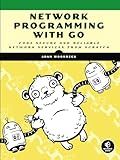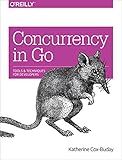Best Go Programming Books to Buy in December 2025

Learning Go: An Idiomatic Approach to Real-World Go Programming



Go Programming Language, The (Addison-Wesley Professional Computing Series)



100 Go Mistakes and How to Avoid Them



Mastering Go: Leverage Go's expertise for advanced utilities, empowering you to develop professional software



Network Programming with Go: Code Secure and Reliable Network Services from Scratch



Black Hat Go: Go Programming For Hackers and Pentesters
- UNLOCK HACKING SKILLS WITH GO PROGRAMMING INSIGHTS FOR PENTESTERS.
- MASTER BLACK HAT TECHNIQUES IN AN EASY-TO-READ PAPERBACK FORMAT.
- ENHANCE SECURITY KNOWLEDGE WITH EXPERT TIPS FOR HACKERS AND TESTERS.



Learn Concurrent Programming with Go



System Programming Essentials with Go: System calls, networking, efficiency, and security practices with practical projects in Golang



Concurrency in Go: Tools and Techniques for Developers


In Go, functions are defined using the func keyword. A typical function definition consists of the keyword func, followed by the function name, a parameter list enclosed in parentheses, an optional return type, and a function body enclosed in curly braces.
Here is a basic function definition:
func add(a, b int) int { return a + b }
In this example, the function name is add, and it takes two parameters a and b of type int. The return type is specified as int. The function body contains the statements that define the behavior of the function.
Functions can be called by using their name followed by the argument list in parentheses. Here's an example of calling the add function and storing the result in a variable:
sum := add(3, 4)
In Go, you can also return multiple values from a function. To do so, you need to specify the return types separated by commas. Here's an example:
func divide(a, b float64) (float64, error) { if b == 0 { return 0, fmt.Errorf("cannot divide by zero") } return a / b, nil }
In this case, the divide function returns a float64 as the result of the division and an error if the denominator is zero. The error handling is done using the fmt.Errorf function to create an error message.
To call a function that returns multiple values, you can assign the values to different variables:
result, err := divide(10.0, 2.0)
In this example, result will contain the result of the division, and err will hold any possible error returned by the function.
Go also supports anonymous functions, which are functions without a name that can be assigned to variables or used as function arguments. Anonymous functions are defined using the func keyword followed by the parameter list and the function body.
Here's an example of an anonymous function that squares a number:
square := func(x int) int { return x * x }
The anonymous function is assigned to the variable square, and it can be invoked just like any other function.
This is a brief overview of defining and using functions in Go. Functions are a fundamental building block in Go, allowing you to organize your code into reusable units of logic.
What is the purpose of return types in Go functions?
The purpose of return types in Go functions is to define and specify the type of value that the function will return when it is executed.
Return types are important as they allow a function to communicate and pass data back to the caller. By specifying the return type, the function can provide the caller with the necessary information or result.
Return types also help in ensuring type safety and clarity in code. By explicitly declaring the return type, it becomes easier for developers to understand and use functions correctly. Return types also play a crucial role in function overloading and method chaining in Go.
What is a closure in Go functions?
In Go, a closure is a function value that references variables from outside its body. It is a combination of a function and the environment in which it was created. This allows the function to access and manipulate variables that are not in its scope.
A closure is created when a function is defined inside another function and it references variables from the outer function. The inner function can then access and use these variables even after the outer function has finished executing. This capability is often used to create anonymous functions that have access to variables in their surrounding context.
Here is an example of a closure in Go:
func OuterFunction() func() int { count := 0
innerFunction := func() int {
count++
return count
}
return innerFunction
}
func main() { increment := OuterFunction() fmt.Println(increment()) // Output: 1 fmt.Println(increment()) // Output: 2 fmt.Println(increment()) // Output: 3 }
In the above example, OuterFunction returns innerFunction, which is a closure. The innerFunction increments the count variable each time it is called and returns the updated value. Since the count variable is defined in the outer function scope, it is accessible and retains its value even after OuterFunction has finished executing.
How to call a function in Go?
To call a function in Go, you need to follow these steps:
- Define the function - Declare the function using the func keyword, followed by the name of the function, arguments (if any), and the return type (if any).
- Implement the function - Inside the function body, define the logic or operations to be executed.
- Call the function - To invoke or call the function, use the function name followed by parentheses. If the function accepts arguments, pass them within the parentheses.
Here is an example of calling a function in Go:
package main
import "fmt"
func sayHello() { fmt.Println("Hello, World!") }
func add(a, b int) int { return a + b }
func main() { sayHello() // Calling function without arguments or return value result := add(2, 3) // Calling function with arguments and return value fmt.Println("Result:", result) }
In the above example, the sayHello function does not accept any arguments or return any values, so it is called without any parentheses.
The add function accepts two arguments a and b of type int and returns the sum of them. It is called with arguments 2 and 3 and the returned result is stored in a variable result, which is then printed in the main function.
What are anonymous functions in Go?
In Go, anonymous functions, also known as lambda functions or function literals, are functions without a name. They are defined inline within the code, rather than being declared separately.
Anonymous functions in Go support the same operations and capabilities as regular named functions, including having parameters, returning values, and accessing variables from the outer scope. They can be assigned to variables, passed as arguments to other functions, or even defined inside other functions.
Here's an example of an anonymous function in Go:
package main
import "fmt"
func main() { greeting := func() { fmt.Println("Hello, world!") }
greeting() // calling the anonymous function
}
In the above code, the greeting variable is assigned an anonymous function that prints "Hello, world!". The anonymous function is then called using the parentheses ().
Anonymous functions are often used in Go for tasks like defining callbacks, implementing goroutines, or avoiding cluttering the code with unnecessary named functions.
What is the syntax for defining a function in Go?
The syntax for defining a function in Go is as follows:
func functionName(parameter1 type, parameter2 type) returnType { // Function body // Code to be executed when the function is called // return statement }
Here's a breakdown of the syntax:
- func: The keyword used to define a function in Go.
- functionName: The name of the function. Choose a meaningful and descriptive name for your function.
- parameter1, parameter2: The parameters that the function accepts. Each parameter has a type, which is specified after the parameter name.
- returnType: The type of value that the function returns after execution. If the function doesn't return any value, use void or ().
- Function body: The code that is executed when the function is called. It is enclosed within curly braces {}.
- return statement: Used to return a value from the function.
Here's an example of a simple function that adds two numbers and returns the result:
func add(x int, y int) int { sum := x + y return sum }
You can also use shorthand syntax if multiple parameters share the same type:
func add(x, y int) int { sum := x + y return sum }
